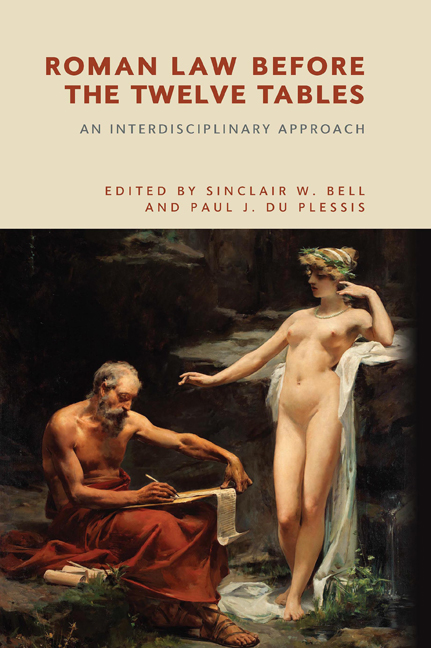Book contents
- Frontmatter
- Contents
- The Contributors
- Introduction: The Dawn of Roman Law
- Part I The Materiality of Roman Law: New Archaeological Discoveries
- 1 Roman Law in its Italic Context
- 2 Central Italian Elite Groups as Aristocratic Houses in the Ninth to Sixth Centuries BCE
- 3 Authority and Display in Sixth-Century Etruria: The Vicchio Stele
- Part II Constructing Early Roman Law: Sources and Methods
- 4 The Twelve Tables and the leges regiae: A Problem of Validity
- 5 The leges regiae in Livy: Narratological and Stylistic Strategies
- 6 The leges regiae through Tradition, Historicity and Invention: A Comparison of Historico-literary and Jurisprudential Sources
- 7 The Laws of the Kings – A View from a Distance
- 8 Beyond the Pomerium: Expansion and Legislative Authority in Archaic Rome
- Part III Roman Law in Historiography and Theory
- 9 Niebuhr and Bachofen: New Forms of Evidence on Roman History
- 10 Finding Melanesia in Ancient Rome: Mauss’ Anthropology of nexum
- Index
6 - The leges regiae through Tradition, Historicity and Invention: A Comparison of Historico-literary and Jurisprudential Sources
Published online by Cambridge University Press: 22 September 2020
- Frontmatter
- Contents
- The Contributors
- Introduction: The Dawn of Roman Law
- Part I The Materiality of Roman Law: New Archaeological Discoveries
- 1 Roman Law in its Italic Context
- 2 Central Italian Elite Groups as Aristocratic Houses in the Ninth to Sixth Centuries BCE
- 3 Authority and Display in Sixth-Century Etruria: The Vicchio Stele
- Part II Constructing Early Roman Law: Sources and Methods
- 4 The Twelve Tables and the leges regiae: A Problem of Validity
- 5 The leges regiae in Livy: Narratological and Stylistic Strategies
- 6 The leges regiae through Tradition, Historicity and Invention: A Comparison of Historico-literary and Jurisprudential Sources
- 7 The Laws of the Kings – A View from a Distance
- 8 Beyond the Pomerium: Expansion and Legislative Authority in Archaic Rome
- Part III Roman Law in Historiography and Theory
- 9 Niebuhr and Bachofen: New Forms of Evidence on Roman History
- 10 Finding Melanesia in Ancient Rome: Mauss’ Anthropology of nexum
- Index
Summary
INTRODUCTION
Existing knowledge of the so-called leges regiae and of the political and institutional profiles of the regnum in general is based on information subjected to a complex literary tradition as well as pieced together from isolated references in Roman legal sources. First-hand evidence is in fact rather limited. Although the Cippus Antiquissimus found in the Roman Forum, dating from between 575 and 565 BCE and considered by some to be a lex regia, is currently the object of some renewed scholarly interest, so far it has offered little clarification with regard to the substantive legal aspects of Rome during the period of the Monarchy.
The collective examination of these sources must be undertaken through an interdisciplinary approach and a careful and critical reading of the information available. In this way, the long and multilayered process of the formation and transmission of historical memory can be understood. In addition, the different forms and varying contents in which such information was received and sometimes reworked by historians, scholars, grammarians, writers, and jurists, from the late Republican Age onwards, can then be assessed.
This methodology also requires a re-examination of the relationship between royal laws and the ius civile Papirianum. The latter is represented as a collection of leges, and certain sources date the collection to the end of the sixth century BCE, having seemingly been created at the initiative of a member of the gens Papiria. On the other hand, the dissemination of the ius civile Papirianum in Roman ‘cultural circles’ is only evident from the first century BCE onwards, which raises the problem of its dating. From the verbatim quotes of royal laws, the only example available to us that seems to have a relationship with this collection and with its commentary, the liber de iure Papiriano, is the lex of the paelex, attributed to King Numa by Festus and Aulus Gellius. A philological analysis of the law suggests that it is substantially authentic, even if we are not able to assert that this was actually drawn up by the king to whom it has been ascribed by tradition.
- Type
- Chapter
- Information
- Roman Law before the Twelve TablesAn Interdisciplinary Approach, pp. 97 - 110Publisher: Edinburgh University PressPrint publication year: 2020



